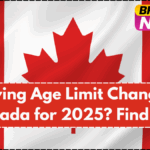Urban speed limits are undergoing major reforms across Canada in June 2025. Municipalities are tightening traffic regulations to enhance pedestrian safety, reduce collisions, and improve the overall flow of traffic. If you drive within city boundaries, you need to stay informed about the latest Speed Limit Changes Urban Canada has implemented. These aren’t just tweaks — many cities are rolling out sweeping updates that will affect daily commuting and driving behavior.

Why Are Urban Speed Limits Being Lowered in 2025?
The push to reduce speed in Canada driving zones comes after a series of studies revealed that lower urban speed limits significantly reduce accident rates and fatalities. Cities like Toronto, Calgary, and Vancouver have cited public safety and sustainable mobility as the primary motivators. Slower speeds give drivers more time to react and reduce the severity of crashes when they occur. Moreover, these changes are aligned with global urban planning trends focusing on walkability and the protection of cyclists.
Breakdown of Speed Limit Adjustments by Major Cities
To give you a clearer view of what’s changing where, here’s a quick look at the new city speed rules in key urban centers:
| City | Previous Urban Limit | New Speed Limit (June 2025) | Notes |
|---|---|---|---|
| Toronto | 50 km/h | 30-40 km/h (neighborhood zones) | Residential streets seeing the biggest drops |
| Vancouver | 50 km/h | 30 km/h (default) | Default limit unless otherwise posted |
| Calgary | 50 km/h | 40 km/h | Applies to most collector and local roads |
| Montreal | 50 km/h | 30-40 km/h | Lowered across schools and bike-heavy areas |
| Halifax | 50 km/h | 40 km/h | Gradual rollout citywide by end of 2025 |
How the Changes Affect Drivers and Commuters
If you’re a daily commuter or delivery driver, these new Canada driving zones limits mean more than adjusting your dashboard habits. Enforcement will be stricter, with many municipalities deploying automated speed enforcement cameras in residential zones and near schools. Insurance companies may also start factoring in tickets for exceeding the new city limits more heavily in premium calculations.
Meanwhile, transit users and cyclists may see improvements in safety and road design. Cities are pairing speed limit changes with new traffic-calming infrastructure: speed humps, raised crosswalks, and narrowed lanes to force slower driving.
What to Do to Stay Compliant With the New Speed Rules
Drivers need to adopt new awareness strategies. Pay attention to new signage, especially in residential areas and near schools. Some cities have introduced digital speed feedback signs to make transitions smoother. Navigation apps like Waze and Google Maps are expected to update their internal databases to reflect the latest city speed rules starting mid-June 2025.
Most importantly, keep an eye on city council updates and transportation department announcements in your area. Ignorance won’t be a valid defense when enforcement begins.
The Bigger Picture: Reimagining Urban Mobility in Canada
The Speed Limit Changes Urban Canada initiative reflects a broader movement toward smarter, safer cities. Reducing speed is part of a larger strategy that includes climate-conscious transport policies, Vision Zero goals, and accessibility improvements. It’s not just about slowing cars—it’s about redefining how Canadian cities move and breathe.
These changes may initially feel inconvenient, but they’re aimed at creating cities where kids can bike safely, seniors can cross streets confidently, and commuters aren’t racing the clock through pedestrian zones.
FAQs
What is the default urban speed limit in Canada as of June 2025?
The default varies by city, but most major municipalities have reduced their urban speed limits from 50 km/h to 30 or 40 km/h in residential and collector areas.
Will these changes be enforced immediately?
Yes. Most cities plan to begin enforcement in June 2025, with some offering grace periods or warning tickets initially.
How can I check the speed limits in my city?
Visit your city’s official transportation or road safety department website. Many cities also provide updated maps and mobile tools.
Are rural or highway speed limits changing too?
No. These changes apply strictly to urban zones within city limits. Rural highways and provincial roads are not affected.
What happens if I get a ticket under the new rules?
Penalties vary by province but can include fines, demerit points, and insurance impacts. Check your province’s Ministry of Transportation site for specifics.
Click here to learn more



